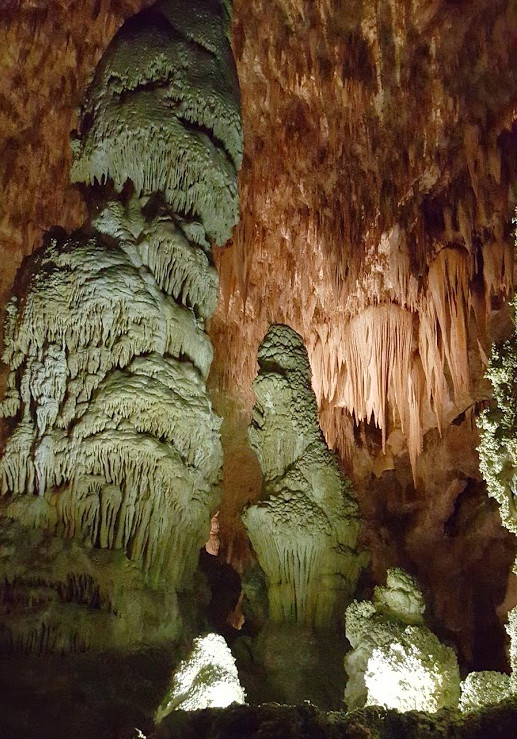
CARLSBAD CAVERNS N.P.
FIELD TRIP STOP – SERIES OF CAVES CARVED BY SULFURIC ACID AND THEN FILLED WITH SPELEOTHEMS.
LOCATION: Carlsbad Caverns is located in southeastern New Mexico. The park entrance is located about 7 miles northwest of White City, NM on the Carlsbad Cavern Highway that leads from US Highway 62/180.
GEOLOGIC FEATURES: Caves initially carved by Sulfuric Acid and subsequently filled with Speleothems such as Stalactites, Stalagmites, and Flowstones among others.
DESCRIPTION: Carlsbad Caverns and Guadalupe Mts. N.P. share nearly the same geologic setting. Rocks mainly represent Permian Reef limestones of Capitan Reef (260-270 mya) with some back-reef limestones found in the northwestern part of the cave and some fore-reef talus in the southeast end. Fossils present in the limestone are the same as found in nearby Guadalupe N.P, namely, calcareous sponges and algae along with bryozoans, brachiopods, echinoderms (crinoids and sea urchins), and molluscs (snails, clams and cephalopods).
Caves found within Carlsbad N.P. are some of the largest in the world. It is thought that hydrogen sulfide derived from oil rising from below the Park and oxygen in the ambient groundwater column combined to form the sulfuric acid that would initialize cave formation. As the Guadalupe Mts. were uplifted during the Tertiary Period, the progressively elevated limestones passed through a zone that has been described as a bath of acid-rich groundwater which resulted in the creation of the large cavernous rooms found at successive levels within the Park. Such a method of formation by sulfuric acid is supported by the presence of gypsum in the cave, a byproduct of such a chemical reaction..
The Spelothems (cave formations such as stalactites and stalagmites) found within Carlsbad Caverns were subsequently formed when groundwater (from rain or snowmelt) rich in dissolved lime moved down from the surface and released carbon dioxide into the cave thereby promoting the precipitation of calcium carbonate in the form of limestone stalactites, stalagmites, flowstones, columns, etc. Most of these Speleothems are no longer growing in the Park due to the dry climate and resulting lack of percolating groundwater.
STUDENT QUESTIONS:
(1) Define a Stalactite and explain how it grows.
(2) Define a Stalagmite and explain how it grows.
(3) How do Stalactites and Stalagmites interact to form a Column?
(4) CHALLENGE: The presence of gypsum in the Park suggests that Sulfuric Acid (derived from rising petroleum) rather than Carbonic Acid (derived from descending groundwater) dissolved the Permian limestone to form the large rooms of Carlsbad. Write the chemical equation to show how the combination of sulfuric acid, limestone, and water yields gypsum.
(5) CHALLENGE: What factors might determine why Speleothems can be so different from place to place withing the caves.
SELECTED REFERENCES:
-Harris, D.V. and E.P. Kiver. 1985 (4th ed.). The Geologic Story of the National Parks and Monuments, John Wiley and Sons, New York, 464 pp.
-NPS. Carlsbad Caverns – Geologic Formations (Updated 12/18/2017). Accessed on 4/6/20:https://www.nps.gov/cave/learn/nature/geologicformations.htm
PHOTOS:
.jpg)
Figure 1 - Natural entrance to Carlsbad Caverns. The large rooms of the cave, dissolved in the Permian Capitan Reef limestone, were created by sulfuric acid initiated by petroleum deposits from below the Caverns.

Figure 2 - Two large Stalagmites (in green light), Stalactites and Drapery (in pink light), and Popcorn (white light). These Speleothems were generated by limestone precipitating from lime-rich solutions as they move downward into the cave and lose carbon dioxide. (Photo by explorer and naturalist Eric Marintsch.)

Figure 3 - Stalactites cover the roof of a large room. The "Totem Pole" Stalagmite is seen in the lower middle part of the photo. (Photo by Eric Marintsch.)

Figure 4 - Closer view of the Totem Pole Stalagmite seen in Figure 3. Stalactites have the form of Drapery. (Photo by Eric Marintsch.)

Figure 5 - Stalagmites growing upward from the cave floor. If Stalactites growing from above meet Stalagmites growing up from the cave floor, a Column is formed. (Photo by Eric Marintsch.)

Figure 6 - Various Stalagmites and Stalactites. (Photo by Eric Marintsch.)

Figure 7 - Stalagmites. (Photo by Eric Marintsch.)

Figure 8 - Popcorn covered Speleothems. (Photo by Eric Marintsch.)

Figure 9 - Draperies.

Figure 10 - Flowstone. (Photo by Eric Marintsch.)